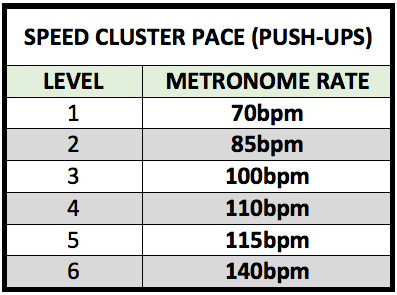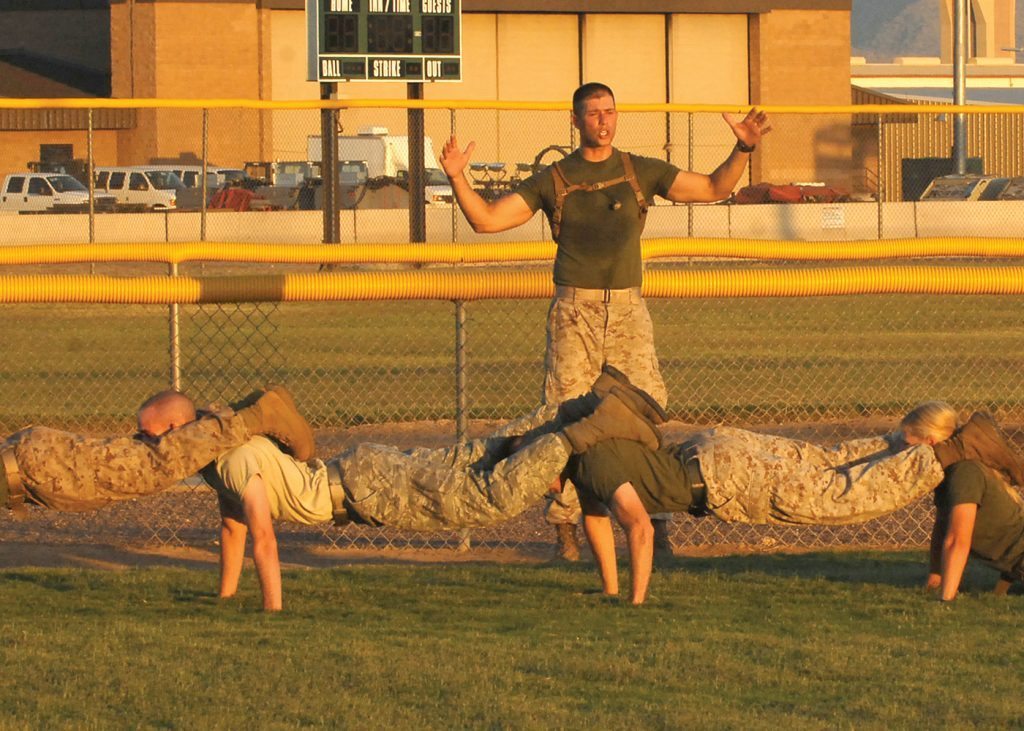HOW TO HACK PUSH-UP ENDURANCE WITH SPEED AND POWER.
I’m going to tell you a little speed secret today, and at the end of this, you’re either going to love me or hate me. Either way, I feel compelled to share this because I’ve got so many people asking for tips regarding push-ups. It occurred to me that I do have a few deep dark secrets locked away that I don’t often share. This is one of them.
Chances are, you’re probably approaching push-up training and testing all wrong. Too much thrust and not enough vector as we used to say. Over the years I have watched a lot of people come and go from special operations. In those many thousands of young men I have watched, coached and mentored, I have noticed patterns. As Tony Robbins says, after interacting with enough people you see certain universal patterns. Bodyweight calisthenics are no different. No one is thinking very deeply about them, and as a result, your quality of action sucks. Remember, the quality of action determines they result!
Speaking of results, let’s look at some old-school advice. Back in the day we always had the same test day recommendation for selection candidates:
- Perform 40 reps as fast as you can, then rest
- Perform 10 reps and rest (total: 50)
- Perform 5 reps and rest (55)
- Perform 5 reps and rest (60)
- Perform 3 reps and rest (63)
- Perform 3 reps and rest (66)
- Perform 2 reps and rest (68)
- Perform 2 reps and rest (70)
- Do doubles and singles until you collapse or time is up.
This almost always gave most of the guys 70-80 push-ups no matter what happened during the week’s training which amounted to one beating after another all day and sometimes all night. It wasn’t actually training; it was seeing who could endure the 12 weeks while still meeting the standards. Believe me, if you were improving it was part of the alarm phase and not because of proper programming! Interestingly, you can take the above method and still pass most PT tests even if you’re not training at all. You can also modify it a little and still crank out decent numbers.
The really big problem I have is that the max push-ups in 2 minutes test is a terrible and stupid test. For one, if your trying to test true strength-stamina, a rest period cannot be allowed! In that last sentence, I think I heard tens of thousands of soldiers gasp in horror that I would suggest such a thing. Sorry lads, it’s true, and until 1980 that’s the way the PT test was – one shot, one kill with max points awarded for 54-60 reps. Now that’s a real test! But I understand that people are not used to that anymore. Don’t despair; there is a way to build some truly terrifying performance in the push-up (among other things) that is fun and challenging. What I am about to tell you is best used in conjunction with cluster training (Click here for details). This is a fact that will immediately become obvious!
WELCOME TO SPEED CLUSTERS
Speed clusters are a nasty little modification I made to traditional cluster training. The reason is that the speed of contraction is a huge deal. For one, if you train too slow, you become slow. Once that happens you cannot access speed. Of course, if you have speed, it’s easy to go slow. That’s just the way nature designed it. Then again, consider that hunting, survival, fighting and athletic competition relies on superior speed and skill. The fact is that we need speed.
The issue of speed is a huge rabbit hole that you can get very much lost in. Take my word for it that speed training is a superior form of strength training for military and athletic performance. The variation I am going to discuss here will build power-endurance and teach you how to pace your efforts, though, it’s a lot nastier than it sounds.
To perform speed clusters you will need a clear space, some water, and a metronome. My favorite at the moment is Metronome+ on the iPhone.
Now for a disclaimer: For the love of Odin, please ease into this and don’t be stupid or cocky. I know that’s wasted on many of you, but those words are going to come back and haunt you.

Now for the method:
- You will be using the cluster method of training and incorporating the speed aspect into the execution of your reps.
- Select your experience/capability level from the chart above. I highly recommend you start at the slowest pace.
- Set your metronome for the pace you have chosen.
- Assume the front leaning rest
- Take a few breaths to synch your mind with the metronome.
- On one beat, descend so that you are at the full bottom of the movement (chest touching the floor) when the next beat sounds.
- Return to the starting up position, settling into the up position as the next note sounds.
- Repeat for the number of reps you have chosen for your clusters.
- When you have completed that number, rest as normal but let the metronome continue until you have performed all of the clusters in that set.
- Rinse and repeat for your entire cluster training session. Use this method for 3-4 weeks but only once per week if you perform multiple sessions. That said, it is always desirable to perform push-ups vigorously.
- When you can perform the entire cluster training session at the lowest speed, advance to the next speed. Your final objective is to be able to perform cluster training at 120 beats per minute (60 reps per min).
- Stretch well!
This is going to be pleasantly nasty for most of you. Give it time and enjoy the ride. Here are a couple of notes:
- 5 clusters of 5 reps is 25 reps per set and 125 reps per session. That’s plenty of reps! If you’re moving at a cadence of 120-140bpm for 5×5 clusters, then get a weight vest and add 2kg at a time.
- If you really want to push the endurance envelope (not sure why you would want to) then work up to 3 clusters of 10 reps. That’s 50 reps per set for 150 reps. After you’re rocking that for 120-140bpm, add weight.
SCIENCE STUFF FOR PERFORMANCE GEEKS
Now that the how-to stuff is out of the way, I want to assure you that the numbers above are in fact science based. Speed training of all types is measured either by speed expressed as meters per second (m/s) or power output in watts. In this method, the pace plugged into the metronome correspond with m/s from0.5m/s to 1.0m/s for the average soldier. Taller outliers will be disadvantaged and shorter outliers will be advantaged but the numbers presented are derived from the average height and arm length. Yes, it’s a very accurate wag designed to be close enough and avoid complicated math.
Since this is for the geeks, understand that the exact type of strength and stamina trained is dependent on the speed of contraction. In this method, we are climbing the ladder from the bottom of accelerative-strength to the top of the ladder of strength-speed. In other words, we’re going from the mere ability to accelerate the body in this movement and crossing into the capacity to express our strength with great speed. To work faster than 140bpm crosses into speed-strength, which is the ability to have high strength behind a very fast movement. The speed-strength zone is between 1.0-1.3m/s (182bpm). If you’re trying to be a fast puncher or swim sprinter, this is territory you will want to explore.



